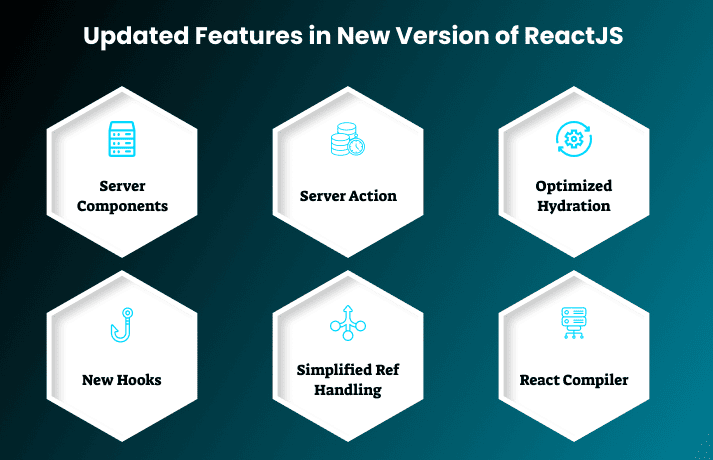Quick Overview: This blog discusses the future of ReactJS and its trends in 2025 and beyond. It also explains why it is still a good choice for modern web development. We talk about how ReactJS keeps getting better, from reusable components and the virtual DOM to new capabilities like Server Components, Concurrent Rendering, and AI/Web3 integration.
Have you ever visited a website with a UI so intuitive that it kept you engaged? Developers get enthusiastic to showcase the latest trends in the industry that are attracting interest. So, of all the most popular things, the values of ReactJS future trends 2025 are just perfect.
Many developers eagerly explore how ReactJS will evolve to benefit them in 2025 and beyond. ReactJS has already taken on the good parts of new tools, features, and practices to stay on top of the latest trends. This blog highlights key ReactJS developments and their potential to transform web development.
ReactJS is a powerful and essential tool for creating interactive and functional websites and applications. This tool enables developers to create user interfaces divided into reusable components. React JS can build and speed up the structure of an app. If you, as a developer, keep up with the current trends in React JS, you will always be ahead of the game. Also, the following trends can help you choose the ideal tools and greatly improve your skills. In this guide we discuss “The Future of ReactJS: What to Expect in 2025 and Beyond,” it’s clear that React.JS is likely to stay a key part of web development in the future.
What is ReactJS ?
Facebook developed React.js, a robust JavaScript library widely used for creating dynamic and responsive user interfaces. It makes it easier for developers to make single-page apps by letting them make reusable UI parts, handle states well, and show updates without having to reload the page. React employs a declarative programming style, allowing developers to describe the UI state and letting React handle updates to the DOM.
The component-based architecture of React is one of its best features. In React, components are small, reusable pieces of code that simplify building and maintaining applications. They make up the user interface. This method makes it easier to keep and grow apps, which makes it easier to handle complicated tasks. Developers may make the development process even better and make cutting-edge apps by using the latest ReactJS trends. React’s virtual DOM ensures fast UI performance by updating only the necessary parts, avoiding a complete re-render.
By using the latest trends in ReactJS, developers can create scalable and high-performance apps that use capabilities like reusable components, SSR, and strong state management. Developers ensure that their projects align with the latest advancements in web development by staying abreast of ReactJS developments. React.js is an essential technology for contemporary web development, to sum up.
Developers looking to create high-performance, interactive apps choose it because of its effectiveness, modularity, and vibrant community. Regardless of your level of experience, learning React brings up a universe of front-end development opportunities while keeping you ahead of the curve with the ReactJS future trends shaping the industry.
Why ReactJS is the Preferred Choice for Modern Web Development
ReactJS has become a leading framework in web development, especially for SPAs, thanks to its reusable components, scalability, and robust performance. Among the top ReactJS trends, features like Server Components, Concurrent Rendering, and seamless integration with tools like Next.js and Redux are reshaping development. With its adaptability to cutting-edge technologies like AI and Web3, ReactJS continues to drive innovation in modern application development. According to BuildWith, React.JS powers 11.9 million websites. to make their user interfaces.
Some standout features of ReactJS include:
- Component-Based Architecture: Allows developers to create reusable and modular components, improving code maintainability and scalability.
- Virtual DOM: Enhances application performance by efficiently updating and rendering only the necessary parts of the UI.
- Declarative UI: Simplifies the process of designing interactive and dynamic user interfaces.
- Strong Ecosystem: Integration with libraries like Redux, React Router, and frameworks like Next.js makes it suitable for a wide range of use cases.
- Cross-Platform Development: React Native extends React’s capabilities to mobile app development, allowing for seamless cross-platform solutions.
React.JS continues to redefine web development, providing developers with tools to build dynamic, efficient, and user-friendly applications that cater to modern business needs.
Also Read : How to Convert HTML Website to ReactJS: Step-by-Step Guide
Updated Features in New Version of ReactJS

React v19 marks a significant milestone in the React ecosystem, officially launched in December 2024. This release adds a number of enhancements designed to improve developer experience, streamline asynchronous activities, and boost speed.
New Features in ReactJS v19
1. Server Components
- Reduces JavaScript sent to the client by rendering parts of the UI on the server.
- Enhances scalability and performance for modern apps.
2. Server Action
- Let’s you run asynchronous server-side functions triggered from the client.
- Streamlines state management and data fetching in applications.
3. Optimized Hydration
- Speeds up the interactivity of server-rendered pages with an improved hydration process.
- Better error handling during hydration ensures smoother debugging.
4. New Hooks
- useActionState: Tracks the state of async actions, such as loading or errors.
- useFormStatus: Monitors form submission status efficiently.
- useOptimistic: Provides tools for optimistic UI updates for better user experience.
5. Simplified Ref Handling
- Function components can directly use ref without requiring forward Ref, simplifying code.
6. React Compiler
- Automatically optimizes React components for improved performance.
- Reduces reliance on manual performance optimizations like useMemo and useCallback.
These features reflect the evolution of React to meet modern and trending web development demands, focusing on performance, scalability, and developer efficiency.
Read More About : Hiring ReactJS Developers in 2025: A Step-by-Step Guide
Comparison of ReactJS with Other Frameworks
ReactJS is often compared to frameworks and tools like Angular, Vue.js, Next.js, and Node.js
1. ReactJS vs. Angular
- Complexity: React is a library for building UI components, while Angular is a complete framework with tools for routing, forms, and state management.
- Performance: React’s virtual DOM ensures efficient rendering, while Angular’s two-way data binding can add overhead.
- Use Case: React is perfect for crafting flexible, dynamic UIs, while Angular thrives in building enterprise-grade applications with its comprehensive framework.
2. ReactJS vs. Vue.js
- Complexity: React relies on external libraries for routing and state management, while Vue offers built-in solutions like Vue Router and Vue.
- Performance: Vue is beginner-friendly with an intuitive API, while React’s JSX and ecosystem require a steeper learning curve.
- Use Case: React excels in scalable apps, while Vue is best for small to medium-sized projects prioritizing simplicity.
3. ReactJS vs. Next.js
- Complexity: React is a UI library, whereas Next.js, built on React, extends its capabilities by offering features such as server-side rendering (SSR), static site generation (SSG), and file-based routing.
- Performance: Next.js enhances React’s capabilities by optimizing for SEO and faster initial load times through SSR and SSG.
- Use Case: Use React for single-page apps; choose Next.js for applications that require SEO optimization and server-side functionality.
4. ReactJS vs. Node.js
- Complexity: React focuses on creating user interfaces for the frontend, whereas Node.js serves as a backend runtime environment for executing JavaScript on the server.
- Performance: React and Node.js work together seamlessly in full-stack applications, with React handling the UI and Node.js managing APIs and server logic.
- Use Case: React is best for interactive user interfaces, while Node.js is essential for building scalable, real-time backend systems
Key Strengths of Each
| Technology | Strengths | Best For |
| ReactJS | UI components, virtual DOM, flexibility | Customizable UIs and SPAs |
| Angular | Comprehensive tools, opinionated structure | Enterprise-grade applications |
| Vue.js | Simplicity, progressive adoption | Small to medium-sized apps |
| Next.js | Server-side rendering, SEO-friendly | Dynamic websites and web apps with SEO focus |
| Node.js | Non-blocking I/O, backend scalability | Server-side APIs, real-time applications |
Choosing the Right Framework
- ReactJS: Flexible and modular, perfect for frontend development.
- Angular: Best for large, structured projects in enterprise environments.
- Vue.js: Ideal for smaller projects that need simplicity and progressive adoption.
- Next.js: Use for web applications requiring SSR, SEO, and server-side logic.
- Node.js: Essential for scalable backend systems and API development.
ReactJS works effectively on its own or in tandem with tools like Next.js and Node.js to create robust, full-stack applications.
Also Read : How to Hire the Best ReactJS Developers in 2025
Expect React JS Trends in 2025 and Beyond
In 2025 and beyond, ReactJS trends will continue shaping modern web development. Innovations like Server Components, Concurrent Rendering, and enhanced integration with AI and Web3 are set to revolutionize how developers build interactive applications. We have listed some of the best ones here for your information.
1. Adoption of Server Components
By outsourcing calculations to the server and combining server-side rendering (SSR) with React’s component-based design, Server Components will improve speed.
2. Advanced Concurrent Features
Through features like Suspense and automated state batching, React’s concurrent mode will enhance app performance and enable smoother rendering and multitasking.
3. AI and Machine Learning Integration
React’s capacity to integrate predictive analytics and deliver personalized user experiences will drive its growing adoption in AI-powered applications.
4. Improved Tooling Ecosystem
As bundlers like Viet and frameworks like Next.js and Gatsby grow, developers will have access to quicker builds, improved performance, and streamlined workflows.
5. Growing Use of TypeScript
As developers place a higher priority on type safety and scalable, maintainable codebases, TypeScript popularity will increase.
6. Enhanced Developer Experience
Tools like React DevTools will evolve, making debugging, performance monitoring, and testing more efficient.
7. Focus on Performance Optimization
React will emphasize faster rendering, efficient memory use, and edge computing compatibility to handle modern performance demands.
8. Expansion of React Native
React Native will grow as a go-to solution for cross-platform development, bridging web and mobile development seamlessly.
9. Web3 Integration
React will adapt to decentralized web trends, offering better support for blockchain, wallets, and smart contract UIs.
10. Community-Driven Innovation
React.JS vibrant open-source community will continue to shape its future by contributing new tools, libraries, and best practices.
Read More About : Why ReactJS is Redefining eCommerce Development in 2025
Why Developers Choose ReactJS ?
Reusable Components for Efficient Development
By using a component-based architecture, ReactJS divides the user interface into more manageable, reusable parts. These elements might be as basic as buttons or as sophisticated as chat windows or comment streams.
- Key Benefit: Each self-contained component facilitates modular and efficient development. This not only enhances the user experience but also enables developers to reuse components across different parts of the application, saving time and effort.
Ease of Learning
React.JS is relatively simple to learn compared to other frontend frameworks. Developers need to understand the basics of JSX, React components, and related HTML and CSS concepts.
- Key Benefit: A solid foundation in these areas allows developers to quickly master ReactJS ecosystem, reducing the learning curve and enabling faster project onboarding.
SEO Optimization Capabilities
ReactJS Server-Side Rendering (SSR) feature significantly improves SEO by ensuring search engines can properly index website content.
- Key Benefit: SSR generates the initial HTML on the server, enhancing visibility and discoverability by making web content fully accessible to search engine crawlers.
Code Stability and High Productivity
ReactJS leverages one-way data binding to ensure a stable codebase. Changes made to a specific component do not impact the entire application.
- Key Benefit: Modular components reduce testing time, streamline development, and improve productivity. This approach minimizes deployment delays, ensuring timely delivery to users.
ReactJS combines ease of use, performance, and flexibility, making it a preferred choice for developers worldwide.
Final Thoughts
Facebook developed React.js, a robust JavaScript library for building dynamic and responsive user interfaces. With reusable UI elements, effective state management, and smooth updates through a virtual DOM, it makes single-page app development easier. Its component-based architecture makes it perfect for complex applications since it improves scalability and maintainability.
React is a flexible platform for projects of various sizes, from business systems to small apps. It supports server-side rendering (SSR) and works with Next.js and Redux. In 2025 and beyond, developers continue to use React.js because of features like Server Components and Concurrent Rendering.
Its versatility allows for the development of cross-platform applications, dynamic user interfaces, and Web3 and AI integration. React is an essential tool for contemporary web development, as seen by its active community and regular updates. Mastering and keeping up with its upcoming ReactJS trends will guarantee success in the rapidly changing frontend development landscape, regardless of your level of experience.
Partner with Krishang Technolab for Your ReactJS Development Needs
Want to use ReactJS to its full potential for your upcoming project? Krishang Technolab, a leading ReactJS development company, specializes in providing state-of-the-art ReactJS development services tailored to meet your business requirements. With our team of seasoned developers and a proven track record, we deliver creativity, scalability, and performance to every project.
Whether you need to build a dynamic online application, enhance your current platform, or create a seamless mobile solution using React Native. Our services ensure your project achieves its full potential. Let’s bring your vision to life with the power of ReactJS.
Get in touch with Krishang Technolab right now to begin turning your concepts into reality!









